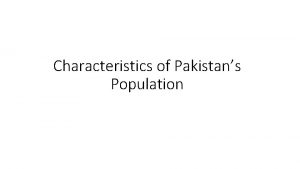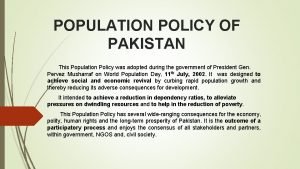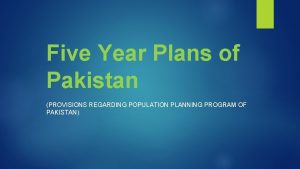Five Year Plans of Pakistan PROVISIONS REGARDING POPULATION






- Slides: 6

Five Year Plans of Pakistan (PROVISIONS REGARDING POPULATION PLANNING PROGRAM OF PAKISTAN)

Second Five Year plan (1960 -65) It took cognizance of the impact of unchecked population growth and made a provision of 15 million rupees for family planning program comprising family planning clinics, training of medical personnel, Educational work and contraceptive research. But the Ministry of Heath, Labour and Social Welfare in 1965 b after reviewing the program came to the conclusion that achievements were much below the expectations. The reasons being: lack of motivation in general masses, unsatisfactory distribution of contraceptives, inadequate education & information in general masses and shortage of administrative personnel.

Sixth Plan’s Review (1983 -88): The sixth plan policy of population planning and welfare aimed at bringing about a behavioural change in favour of small family norm through concerted efforts of NGOs and distribution of contraceptives by commercial enterprise. Seventh Five Year Plan (1988 -93): This plan aimed that “ Overall policy will attempt to bring about a behavioural change in favour of small family norm through voluntary birth intervals, care of pregnancy and safe delivery. Fertility management will be the key objective and a multi-sectoral approach will be followed by involving all minstries and departments”.

Eighth Five Year Plan (1993 -98): Its objective was to reduce growth rate fro 2. 9 percent (1992 -93) to 2. 7 per annum by 1997 -1998 and 2. 6 by 2000. The main thrust of the program remained the expansion of family planning services by the creation of infrastructure in the rural areas supported by a motivational campaign.

Implementation of the Program: While planning, information, training, supplies, evaluation and research, coordination and foreign assistance is managed at the Federal level, the programs are implemented by the provinces. Each District is headed by a Population Welfare Officer to organize and coordinate the program activities. Within this framework the program comprises: a) Core Program b) Complementary Projects c) Support Activities The Core program includes the following projects: i. Family Welfare Centres (FWCs) ii. The Reproductive Health Services iii. The family Health and Manpower Development iv. Mobile Service Units v. Community Bsed Service Deliver System in Rural Areas

Shortcomings of the Program: Inspite of several reorganizations and changes in approaches of the family planning program in Pakistan, there has not been a significant success. However, the two major factors accounting for Pakistan’s failure in this field are: Ø Socio-cultural backwardness which explains why women are denied their basic rights and status Ø Non-availability of reproductive health facilities because of the apathy of the authorities.











